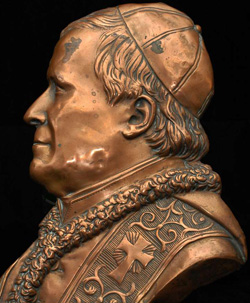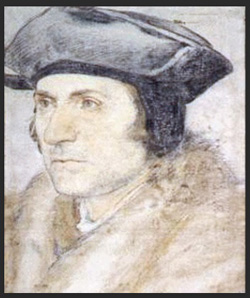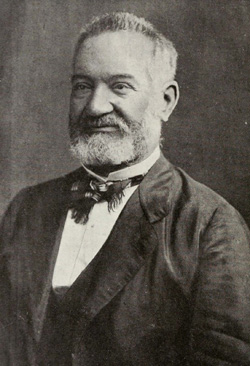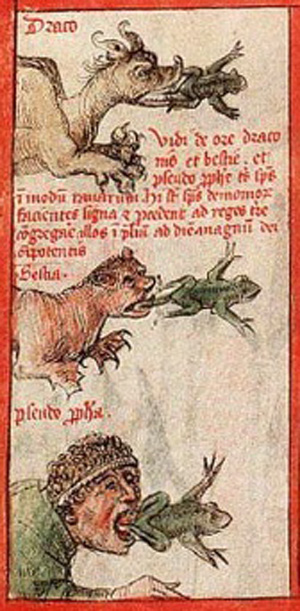About the Church
 |
 |
 |
 |
 |
 |
 |
The Role of Laymen in the Church – I
Should Laymen Defend the Church?
Could They Criticize Priests & Bishops?
TIA has received various objections regarding the article "Three Questions to Fr. Pagliarani." In it Atila Guimarães respectfully asks the Superior of the SSPX questions about the official positions issued on Francis' Motu Proprio Traditionis custodes.
Most of the objections boil down to a simple "How dare you, a layman, question a priest?" Even before this article was posted, I was aware that other priests of traditional or conservative orientation have spoken heatedly about how the role of the layman is to obey and pray, and never to question a priest or criticize him.
Summarizing, there are two connected objections directed to laymen:
To demonstrate it I will divide my answer into four parts:
I - Historic Precedents;
II - Natural Law;
III - Theological Doctrine;
IV - Canon Law
I. Historic Precedents
Throughout History, lay Saints have risen up to defend and protect Holy Mother Church against heresies and errors. There are numerous examples of laymen – some of them Saints – who fulfilled their religious duty to defend the Church and publicly challenge those who deviated from the orthodox road, even when the wrongdoers were priests, bishops or popes.
1. St. Joseph
 A preliminary fact to be considered in this discussion is that, because he was the head of the Holy Family, the Catholic Church chose St. Joseph to be the Protector of the Church.
A preliminary fact to be considered in this discussion is that, because he was the head of the Holy Family, the Catholic Church chose St. Joseph to be the Protector of the Church.
So, the whole Church is entrusted to the care of this Great Patriarch, who was not a member of the Hierarchy, but a simple layman.
The very foundation of these two objections is destroyed by the fact that the Church officially chose St. Joseph to be her Defender.
2. Our Lady of La Salette
The best example of a layperson – a woman – who criticized the Hierarchy and the clergy is Our Lady. She appeared in La Salette to warn the world that the clergy would becomes a "cesspool of impurity" and Rome would become the "seat of the Antichrist."
Although Our Lady was a model for religious women during the period when she was living in the Temple, later she left it to marry St. Joseph and enter the lay state as a Wife and Mother.
If to criticize Popes and clergy were inappropriate for a layperson and the act of a false prophet then these condemnations would apply to Our Lady, which is absurd.
This same argument is valid for many other apparitions in which Our Lady warned the faithful about the coming apostasy of the Hierarchy and clergy.
3. St. Catherine of Siena
Another lay woman, St. Catherine of Siena, was a stern critic of Pope Gregory XI remaining in Avignon. Later, she did not hesitate to reprove Pope Urban VI as well.
Someone might object that she made private, not public criticisms to the Pope in letters. Although it is pertinent that originally her admonishments were private, by canonizing St. Catherine and making her correspondence public, including those critiques of the Pope, the Church showed her approval for those laudable actions of St. Catherine and presented her as an example to be followed by all Catholics.
4. St. Thomas More
 A brilliant example of a lay Saint who confronted almost the whole English Hierarchy of the time to defend the Faith was St. Thomas More, who died a martyr for opposing the King and the Hierarchy and defending the Catholic doctrine.
A brilliant example of a lay Saint who confronted almost the whole English Hierarchy of the time to defend the Faith was St. Thomas More, who died a martyr for opposing the King and the Hierarchy and defending the Catholic doctrine.
Even before he faced the martyr's death, Thomas More took as his mission the rooting out of heretics during his term as Chancellor from 1529 to 1532. In fact, one of his main purposes in accepting the office of Chancellor was to protect the Church against heretical enemies and punish them. Was he wrong as a layman to enter that field of battle against the Bishops who shortly afterward would be condemned as heretics? Absolutely not.
5. St. Clement Hofbauer
When he was still a young man in school, he confronted priests and seminarian professors. He publicly declaimed their concessions to Rationalism and their denial of the dogma of the Immaculate Conception. He was still a youth, but he did not hesitate to speak out when he heard error being taught publicly by learned clergymen.
6. Holy Seers
Bl. Ana Maria Taigi (here and here), Bl. Elizabeth Canori Mora and other lay holy seers left prophecies that speak about a great apostasy in the Hierarchy and clergy. The Church allowed their writings to be made public. Independent of whether or not one believes in those predictions, they can be correctly considered as strong criticisms of the Hierarchy and clergy.
7. Illustrious lay men still not canonized
Among many famous lay Catholics who criticized ecclesiastics, I bring forth only two:
Louis Veuillot
 Notable among the Catholic Ultramontane laymen was the French polemicist, Louis Veuillot (1813-1883), editor of the counter-revolutionary Catholic newspaper,
L’Univers. He did not fear to rail out strongly against the compromises of the clerical elite of the French Church, whom he described as "spinelessly kowtowing to their liberal puppet-masters."
Notable among the Catholic Ultramontane laymen was the French polemicist, Louis Veuillot (1813-1883), editor of the counter-revolutionary Catholic newspaper,
L’Univers. He did not fear to rail out strongly against the compromises of the clerical elite of the French Church, whom he described as "spinelessly kowtowing to their liberal puppet-masters."
His fight was particularly turned against Msgr. Felix Dupanloup, Bishop of Orleans, one of the leaders of Catholic Liberalism in France and one of the heads of the Liberal current at the First Vatican Council.
A proof that Veuillot was correct in defending the Church is the magnificent eulogy of his work delivered by St. Pius X in 1913 on the centenary of the birth of this fiery and gifted French apologist, one of the highest tributes a Catholic can receive from a Pope.
Orestes Brownson
Another distinguished laymen who entered the public fight against ecclesiastics who were promoting the principles of Liberalism is New England intellectual Orestes Brownson. He wrote and published a stinging critique against Card. John Henry's Newman's Essay on the Development of Christian Doctrine. Newman, today called "the theologian of Vatican II," championed the reforming trends on many matters of theology that were later adopted by the Council.
Brownson was praised for his fight against Liberalism by Pope Pius IX.
First conclusion
The simple presentation of these cases of laypersons defending the Church in the past puts to rest the two mentioned objections.
We see that it is appropriate and good for laypersons to defend the Church. We also see that neither is it wrong – e.g. inappropriate, proud, arrogant – for a layperson to criticize ecclesiastics nor is this action per se characteristic of false prophets.
Continued

Most of the objections boil down to a simple "How dare you, a layman, question a priest?" Even before this article was posted, I was aware that other priests of traditional or conservative orientation have spoken heatedly about how the role of the layman is to obey and pray, and never to question a priest or criticize him.
Summarizing, there are two connected objections directed to laymen:
- Do not try to save the Church. It is not the mission of laymen to try to save the Church because the Church does not need anyone for that: The Holy Ghost and Our Lord by means
of the Hierarchy and clergy will take care of the defense of the Church. Instead, you should concentrate on saving your soul and becoming a saint.
Persons who say they are fighting to defend the Church are arrogant and can be characterized as false prophets. To speak too much about error, evil and crisis in the Church is a sign of a false prophet. The real saint speaks primarily about the grandeur of God and the beauty of virtue, instead of focusing on the news and scandals in the Church.
Malicious priests accuse laymen who defend the Church of being false prophets
- You should never criticize or question a priest, bishop or pope because the role of the layman is to obey the Hierarchy and clergy. No laymen should criticize a superior, but should endure everything he says with meekness and humility. If you criticize publicly, you are going against your role and showing pride.
To demonstrate it I will divide my answer into four parts:
I - Historic Precedents;
II - Natural Law;
III - Theological Doctrine;
IV - Canon Law
I. Historic Precedents
Throughout History, lay Saints have risen up to defend and protect Holy Mother Church against heresies and errors. There are numerous examples of laymen – some of them Saints – who fulfilled their religious duty to defend the Church and publicly challenge those who deviated from the orthodox road, even when the wrongdoers were priests, bishops or popes.
1. St. Joseph

December 8, 1870: Pius IX named St. Joseph Protector of the Church
So, the whole Church is entrusted to the care of this Great Patriarch, who was not a member of the Hierarchy, but a simple layman.
The very foundation of these two objections is destroyed by the fact that the Church officially chose St. Joseph to be her Defender.
2. Our Lady of La Salette
The best example of a layperson – a woman – who criticized the Hierarchy and the clergy is Our Lady. She appeared in La Salette to warn the world that the clergy would becomes a "cesspool of impurity" and Rome would become the "seat of the Antichrist."
Although Our Lady was a model for religious women during the period when she was living in the Temple, later she left it to marry St. Joseph and enter the lay state as a Wife and Mother.
If to criticize Popes and clergy were inappropriate for a layperson and the act of a false prophet then these condemnations would apply to Our Lady, which is absurd.
This same argument is valid for many other apparitions in which Our Lady warned the faithful about the coming apostasy of the Hierarchy and clergy.
3. St. Catherine of Siena
Another lay woman, St. Catherine of Siena, was a stern critic of Pope Gregory XI remaining in Avignon. Later, she did not hesitate to reprove Pope Urban VI as well.
Someone might object that she made private, not public criticisms to the Pope in letters. Although it is pertinent that originally her admonishments were private, by canonizing St. Catherine and making her correspondence public, including those critiques of the Pope, the Church showed her approval for those laudable actions of St. Catherine and presented her as an example to be followed by all Catholics.
4. St. Thomas More

St. Thomas More
Even before he faced the martyr's death, Thomas More took as his mission the rooting out of heretics during his term as Chancellor from 1529 to 1532. In fact, one of his main purposes in accepting the office of Chancellor was to protect the Church against heretical enemies and punish them. Was he wrong as a layman to enter that field of battle against the Bishops who shortly afterward would be condemned as heretics? Absolutely not.
5. St. Clement Hofbauer
When he was still a young man in school, he confronted priests and seminarian professors. He publicly declaimed their concessions to Rationalism and their denial of the dogma of the Immaculate Conception. He was still a youth, but he did not hesitate to speak out when he heard error being taught publicly by learned clergymen.
6. Holy Seers
Bl. Ana Maria Taigi (here and here), Bl. Elizabeth Canori Mora and other lay holy seers left prophecies that speak about a great apostasy in the Hierarchy and clergy. The Church allowed their writings to be made public. Independent of whether or not one believes in those predictions, they can be correctly considered as strong criticisms of the Hierarchy and clergy.
7. Illustrious lay men still not canonized
Among many famous lay Catholics who criticized ecclesiastics, I bring forth only two:
Louis Veuillot

Louis Veuillot
His fight was particularly turned against Msgr. Felix Dupanloup, Bishop of Orleans, one of the leaders of Catholic Liberalism in France and one of the heads of the Liberal current at the First Vatican Council.
A proof that Veuillot was correct in defending the Church is the magnificent eulogy of his work delivered by St. Pius X in 1913 on the centenary of the birth of this fiery and gifted French apologist, one of the highest tributes a Catholic can receive from a Pope.
Orestes Brownson
Another distinguished laymen who entered the public fight against ecclesiastics who were promoting the principles of Liberalism is New England intellectual Orestes Brownson. He wrote and published a stinging critique against Card. John Henry's Newman's Essay on the Development of Christian Doctrine. Newman, today called "the theologian of Vatican II," championed the reforming trends on many matters of theology that were later adopted by the Council.
Brownson was praised for his fight against Liberalism by Pope Pius IX.
First conclusion
The simple presentation of these cases of laypersons defending the Church in the past puts to rest the two mentioned objections.
We see that it is appropriate and good for laypersons to defend the Church. We also see that neither is it wrong – e.g. inappropriate, proud, arrogant – for a layperson to criticize ecclesiastics nor is this action per se characteristic of false prophets.
Continued

Posted on August 27, 2021














